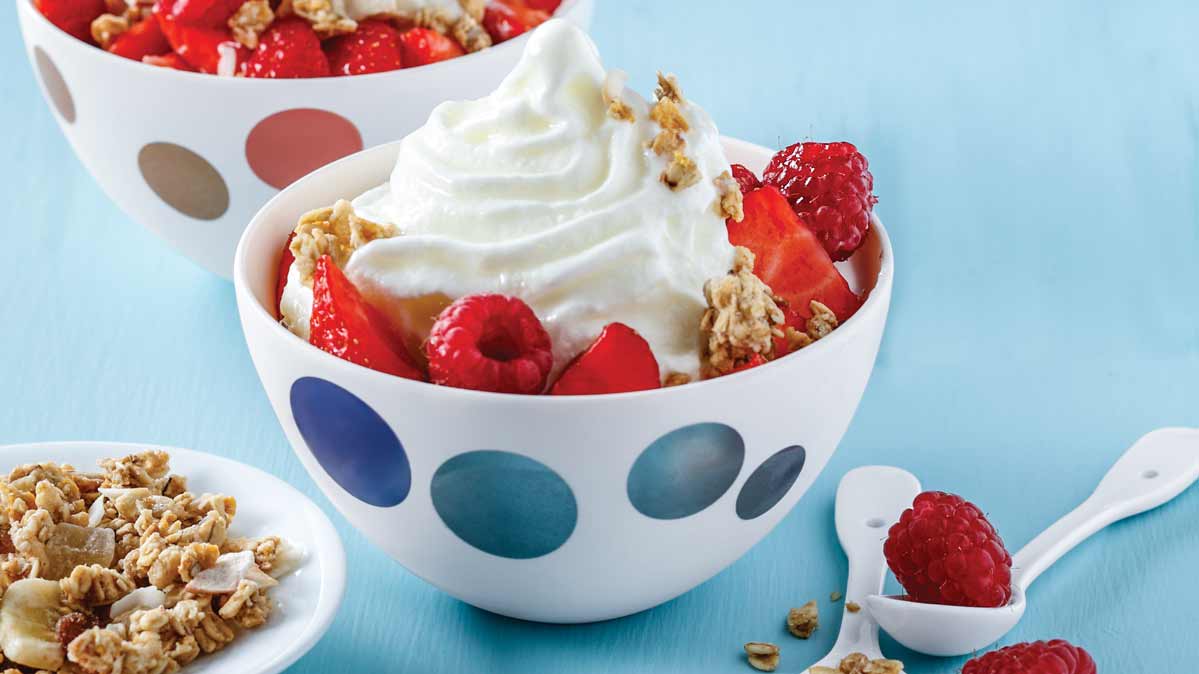
Trying to get down to the recommended level of sugar all at once can feel overwhelming. Follow this plan and you can easily reduce your sugar intake over the course of a few weeks while still indulging your sweet tooth on occasion.
Step 1: Know how much you eat. “Take a look at what treats you have during your average day, and be mindful of how it adds up,” Dunn says. Notice habits you might be able to adjust—such as always grabbing a doughnut when you buy a cup of coffee in the morning, reaching for a sugary pick-me-up in the afternoon, and having dessert every night. Cutting out just one of those each week will help with your overall sugar intake.
Then focus on how sweet your food tastes. “So many foods—even savory ones like bread and salad dressing—contain added sugars, and that’s trained our taste buds to expect that sweetness in nearly everything we eat,” says Rachel Cheatham, PhD, an adjunct assistant professor at the Tufts Friedman School of Nutrition Science and Policy in Boston. As you cut back, “you may start to notice that things like cake taste overly sweet and that foods you never thought of as sweet—like carrots and apples—have a pleasantly sweet taste,” she says. As you become more aware of the sweetness in foods, your preferences will begin to shift.
Step 2: Start reading food labels. Sugar sneaks its way into many otherwise healthy foods. Once you start paying attention you may be surprised to find, say, 5 grams of added sugars in a slice of Dave’s Killer 21-grain bread, 14 grams in a serving of Cascadian Farm Oats & Honey granola, and 11 grams in a 4.5-ounce tub of Noosa vanilla-bean yogurt. Other surprising sources include pasta sauce, salad dressing, marinades, barbecue sauce, ketchup, and snack bars. Choosing the option lowest in added sugars is an easy way to eliminate several grams of sugar a day. You won’t miss it, and that way you can save the sugar you do consume for something where it really matters.
Know too, that added sugars go by many names, but your body responds to them in the same way it does table sugar. “Even if the ingredient comes from a natural source—like honey or agave—it is still ‘added sugar’ because it doesn’t occur naturally in that food,” Dunn says. In addition to honey and agave, these are all added sugars: barley malt, brown rice syrup, cane sugar, coconut sugar, corn syrup, dextrose, fruit juice concentrate, high-fructose corn syrup, maltodextrin, and molasses.
Step 3: Check your drinks. Sweetened drinks are the No. 1 source of added sugars in the American diet. But soda isn’t the only culprit. Sweetened iced tea packs a sugary punch: A 16-ounce bottle of Snapple Peach Tea contains 40 grams of added sugars. And don’t forget about the coffee shop. Asking for vanilla-flavored syrup in your latte adds up to 20 grams of sugar to your cup; a Starbucks Grande Frappuccino contains 45 grams. Compare that with 37 grams in a 12-ounce can of cola.
Although trading sweet drinks for water is the healthiest move, it’s not the easiest. “Come up with a swap that’s as close as possible to what you’re replacing,” says Lauri Wright, PhD, chair of the department of nutrition and dietetics at the University of North Florida in Jacksonville. “Find a way to replicate the fizz and the sweetness if you’re trying to give up soda.” She suggests trying sparkling water flavored with mint leaves, citrus, or a splash of fruit juice. For coffee and tea drinks, a spice such as cinnamon or nutmeg will add flavor without sugar.
Step 4: Add your own. If you want to add sweetness to drinks or food, start doing it yourself. “Buying unsweetened tea or coffee allows you to control how much sugar you add,” Wright says. You’re unlikely to spoon in the dozen or more teaspoons of sugar that you’d get in a presweetened drink. The same holds true for foods like cereal, oatmeal, and yogurt. Buy plain versions and mix in your own sugar, honey, or syrup. See if you can gradually reduce it from 2 teaspoons to 1, then down to ½ teaspoon over the course of a few weeks.
And if a bowl of fruit seems like a sad substitute for the rich dessert you’re craving, dress it up a little. Two tablespoons of Reddi-wip contains less than a gram of added sugar but can turn fresh strawberries into something that seems more indulgent.
Step 5: Rethink recipes. When you’re baking, experiment with using less sugar than the recipe calls for. Cutting even 10 percent will eliminate 5 teaspoons for every cup of sugar in the recipe. In some cases you may be able to reduce the sugar by 25 percent. You can also try swaps, like replacing sugar in a muffin recipe with unsweetened applesauce. “Stepping down the level of sweetness (rather than counting every gram of sugar) helps your palate adjust to less sugar and helps you crave sweetness less,” Cheatham says. When you do indulge, do it wisely. “Portion size and frequency matter,” she adds. “If it’s a treat you want to give yourself daily, enjoy just a small amount.”
Editor’s Note: A version of this article also appeared in the August 2021 issue of Consumer Reports on Health.
"eat" - Google News
July 18, 2021 at 11:42PM
https://ift.tt/3iqwly6
How to Eat Less Sugar - ConsumerReports.org
"eat" - Google News
https://ift.tt/33WjFpI
https://ift.tt/2VWmZ3q
Bagikan Berita Ini














0 Response to "How to Eat Less Sugar - ConsumerReports.org"
Post a Comment